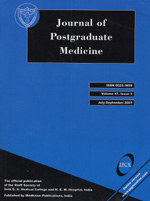
|
Journal of Postgraduate Medicine
Medknow Publications and Staff Society of Seth GS Medical College and KEM Hospital, Mumbai, India
ISSN: 0022-3859
EISSN: 0022-3859
Vol. 56, No. 1, 2010, pp. 21-23
|
 Bioline Code: jp10006
Bioline Code: jp10006
Full paper language: English
Document type: Research Article
Document available free of charge
|
|
|
Journal of Postgraduate Medicine, Vol. 56, No. 1, 2010, pp. 21-23
| en |
Cesarean delivery in preeclampsia and seasonal variation in a tropical rainforest belt
Okafor, U. V. & Ezegwui, H. U.
Abstract
Background: The pathogenesis of preeclampsia is poorly understood and recent evidence suggests that the incidence varies depending upon the season.
Aim: This study was carried out to determine whether there is a seasonal variation in the presentation of preeclamptics undergoing cesarean delivery in a tropical rainforest
belt.
Setting: A university teaching hospital.
Study Design: Retrospective.
Materials and Methods: The hospital records of consecutive patients
(July 1996-June 2006) with preeclampsia, who underwent cesarean delivery in a tertiary care centre, were reviewed. Data collected included patient demographics, total number of deliveries,
number of cesarean deliveries, and number of preeclampsia patients and time of presentation for cesarean section. Approval of the local ethical committee was obtained.
Statistical Analysis: The EPI info software program was used for statistical analysis.
Results: A total of 6798 deliveries were recorded during the study
period resulting in 6485 live births. There were 1579 cesarean deliveries during the period. Of these, 196 patients had toxemia of pregnancy (166 with preeclampsia and 30 with eclampsia).
One hundred and forty-one patients (9% of cesarean deliveries) had cesarean delivery during the rainy season and 55 (3.5%) during the dry season (P < 0.05). Amongst
preeclampsia patients, 115 presented (7%) during the rainy season and 51 (3.2%) during the dry season (P < 0.05). In the eclampsia group, 26 (1.65% of
cesarean sections) presented during the rainy season and four (0.25%) during the dry season (P < 0.05).
Conclusions: There was a seasonal variation
in the cesarean delivery required for preeclampsia/eclampsia patients. This may help in counseling women on when to plan their pregnancy in order to reduce the morbidity and mortality
associated with this apparent seasonal disease.
Keywords
Cesarean delivery, eclampsia, preeclampsia, rainy and dry seasons, tropical climate
|
| |
© Copyright 2010 Journal of Postgraduate Medicine.
Alternative site location: http://www.jpgmonline.com
|
|
